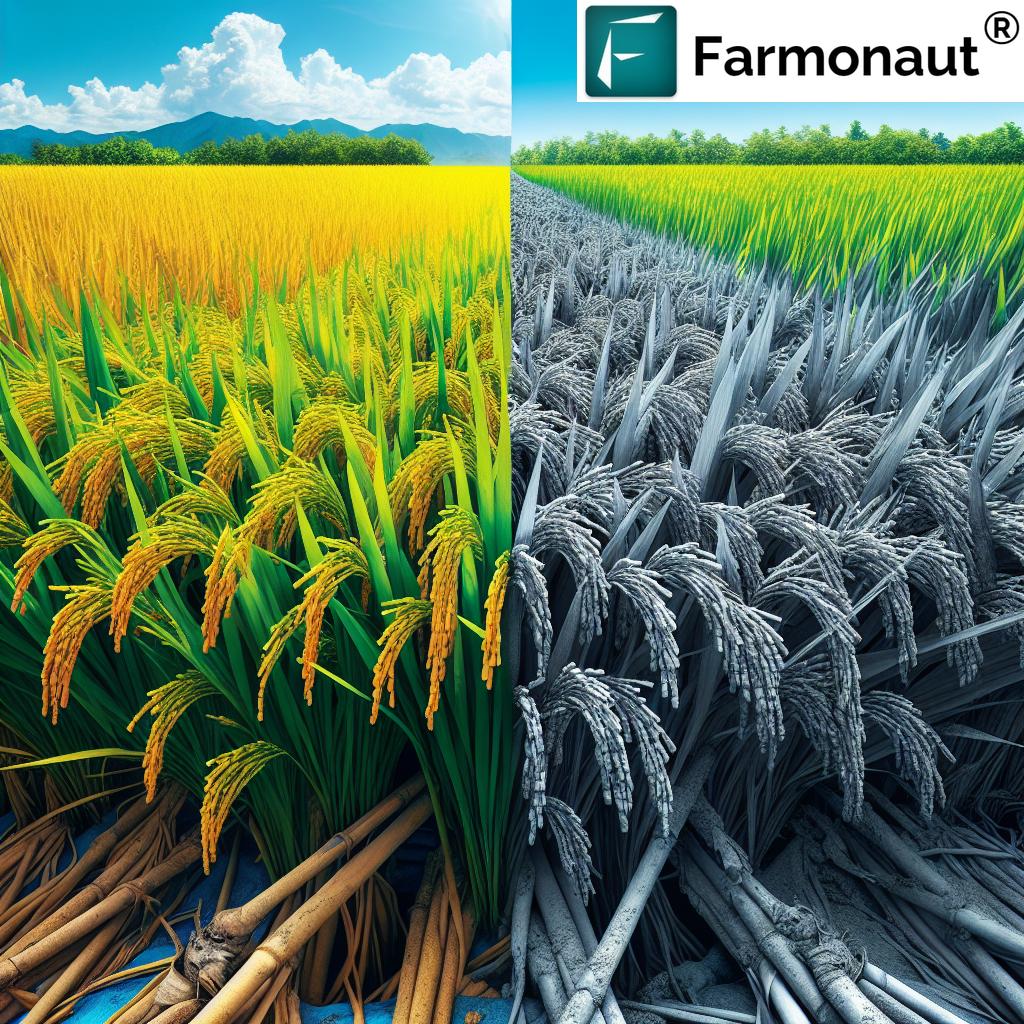
Rice Blast Disease: A Comprehensive Guide for Farmers
Rice blast disease, caused by the fungus Magnaporthe oryzae (formerly known as Magnaporthe grisea), is one of the most devastating diseases affecting rice crops worldwide. As experts in agricultural technology and crop management, we at Farmonaut understand the critical importance of early detection and effective management of this disease. In this comprehensive guide, we will explore the symptoms, causes, and control methods for rice blast, empowering farmers with the knowledge they need to protect their crops and maximize yields.
Understanding Rice Blast Disease
Rice blast is a fungal disease that can affect all above-ground parts of the rice plant, including leaves, stems, nodes, and panicles. The disease is particularly problematic in regions with high humidity and moderate temperatures, making it a significant concern for rice farmers across various climatic zones.
The Causative Agent: Magnaporthe oryzae
Magnaporthe oryzae is a highly adaptable fungal pathogen that can infect rice plants at any growth stage. This fungus produces spores called conidia, which are dispersed by wind or water splash, leading to rapid spread of the disease under favorable conditions.
Environmental Factors Contributing to Rice Blast
Several environmental factors contribute to the development and spread of rice blast:
- High humidity (above 90%)
- Moderate temperatures (between 20-30°C)
- Extended periods of leaf wetness
- Excessive nitrogen fertilization
- Drought stress
Understanding these factors is crucial for implementing effective preventive measures and management strategies.
Recognizing Rice Blast Symptoms
Early detection of rice blast is essential for timely intervention and minimizing crop losses. The symptoms can vary depending on the part of the plant affected and the stage of infection.
Leaf Blast Symptoms
Leaf blast is often the first visible sign of infection. Key symptoms include:
- Small, water-soaked spots that enlarge into diamond-shaped lesions
- Lesions with gray centers and brown borders
- Coalescence of lesions, leading to large areas of necrosis
- A “burnt” appearance of severely infected leaves
Node and Collar Blast Symptoms
As the disease progresses, it can affect the nodes and collar regions of the rice plant:
- Dark brown to black lesions on stem nodes
- Grayish necrosis at the collar region
- Weakening and potential breakage of the stem at infected nodes
Panicle and Neck Blast Symptoms
Rice blast can severely impact grain production when it affects the panicles and neck region:
- Brown lesions on the neck (the topmost internode)
- Whitish or grayish necrosis of panicles
- Partial or complete sterility of infected panicles
- Poor grain filling and reduced grain quality

The Impact of Rice Blast on Crop Yield and Quality
Rice blast can have devastating effects on both crop yield and quality:
- Reduced photosynthetic capacity due to leaf damage
- Decreased nutrient and water uptake from infected tissues
- Significant yield losses, ranging from 10% to 30% in moderate cases, and up to 100% in severe outbreaks
- Reduced grain quality, affecting market value
- Increased susceptibility to other pests and diseases
Diagnosis and Monitoring of Rice Blast
Accurate diagnosis and continuous monitoring are crucial for effective management of rice blast. At Farmonaut, we leverage advanced satellite technology to assist farmers in early detection and monitoring of crop health issues, including rice blast.
Traditional Diagnostic Methods
Conventional methods for diagnosing rice blast include:
- Visual inspection of plants for characteristic symptoms
- Microscopic examination of infected tissues for fungal structures
- Laboratory culturing and identification of the pathogen
Advanced Diagnostic Techniques
Modern diagnostic approaches enhance accuracy and speed:
- Polymerase Chain Reaction (PCR) for rapid pathogen identification
- Enzyme-Linked Immunosorbent Assay (ELISA) for detecting fungal antigens
- DNA sequencing for precise strain identification
Satellite-Based Monitoring with Farmonaut
Our satellite-based crop health monitoring system offers several advantages for rice blast detection and management:
- Early detection of crop stress indicators that may signal blast infection
- Large-scale monitoring of rice fields without the need for physical inspection
- Regular updates on crop health status, allowing for timely interventions
- Integration with our AI-powered advisory system for personalized management recommendations
To experience the benefits of our satellite-based monitoring system, visit Farmonaut’s App.
Comparison: Traditional Methods vs. Farmonaut Satellite System for Rice Blast Detection
| Feature | Traditional Methods | Farmonaut Satellite System |
|---|---|---|
| Detection Speed | Slow (requires physical field visits) | Fast (real-time satellite imagery analysis) |
| Accuracy | Variable (depends on inspector’s expertise) | High (uses advanced algorithms and spectral analysis) |
| Coverage Area | Limited (sample-based) | Extensive (entire field monitored simultaneously) |
| Cost-effectiveness | Low (labor-intensive, time-consuming) | High (automated, requires minimal manual intervention) |
Rice Blast Disease Management Strategies
Effective management of rice blast requires an integrated approach combining preventive measures, cultural practices, and targeted interventions. At Farmonaut, we advocate for a holistic management strategy that balances effectiveness with environmental sustainability.
Cultural Control Methods
Implementing proper cultural practices can significantly reduce the risk of rice blast infections:
- Crop rotation with non-host crops to break the disease cycle
- Proper field sanitation, including removal of crop residues
- Balanced fertilization, avoiding excessive nitrogen application
- Water management to avoid prolonged leaf wetness
- Planting resistant rice varieties when available
Biological Control Approaches
Biological control methods offer environmentally friendly alternatives for managing rice blast:
- Application of beneficial microorganisms that compete with or antagonize M. oryzae
- Use of plant extracts with antifungal properties
- Introduction of natural predators or parasites of the pathogen
Chemical Control Measures
While we prioritize sustainable practices, chemical control may be necessary in severe cases:
- Application of systemic fungicides for curative treatment
- Use of protectant fungicides for preventive control
- Seed treatments to protect young seedlings
It’s crucial to use chemical treatments judiciously and in compliance with local regulations to prevent fungicide resistance and minimize environmental impact.
Organic and Sustainable Control Methods
At Farmonaut, we strongly support organic and sustainable approaches to rice blast management:
- Use of compost and organic fertilizers to improve plant health and resistance
- Application of biopesticides derived from natural sources
- Implementation of push-pull strategies using companion planting
- Enhancing biodiversity in and around rice fields to promote natural pest control
Integrated Pest Management (IPM) for Rice Blast
We recommend an Integrated Pest Management (IPM) approach for comprehensive rice blast control. This strategy combines various methods to achieve effective disease management while minimizing environmental impact:
- Prevention:
- Use of resistant rice varieties
- Proper field preparation and sanitation
- Optimal planting dates to avoid peak disease periods
- Monitoring:
- Regular field scouting for early symptoms
- Utilization of Farmonaut’s satellite-based crop monitoring system
- Weather monitoring to predict favorable disease conditions
- Decision-making:
- Establishing economic thresholds for intervention
- Considering the crop growth stage and weather forecasts
- Evaluating the potential impact on beneficial organisms
- Intervention:
- Prioritizing cultural and biological control methods
- Applying chemical controls only when necessary
- Rotating control methods to prevent resistance development
The Role of Technology in Rice Blast Management
At Farmonaut, we harness cutting-edge technology to enhance rice blast management:
Satellite-Based Crop Monitoring
Our satellite monitoring system provides valuable insights for rice blast management:
- Early detection of crop stress that may indicate blast infection
- Mapping of disease spread across large areas
- Monitoring of crop response to treatments
To access our satellite monitoring services, visit Farmonaut’s Satellite API.
AI-Powered Advisory System
Our Jeevn AI advisory system offers personalized recommendations for rice blast management:
- Custom treatment plans based on field-specific data
- Predictive modeling of disease progression
- Optimization of resource allocation for disease control
Mobile Applications for On-the-Go Management
Farmonaut’s mobile apps provide farmers with tools for effective rice blast management:
- Real-time alerts for potential disease outbreaks
- Access to expert advice and treatment guidelines
- Documentation and tracking of field observations and treatments
Download our mobile app for Android from the Google Play Store or for iOS from the App Store.
Future Perspectives in Rice Blast Management
As we look to the future, several promising developments are on the horizon for rice blast management:
Genetic Engineering and CRISPR Technology
Advancements in genetic engineering, particularly CRISPR-Cas9 technology, offer potential for developing rice varieties with enhanced resistance to blast. This could lead to more durable and effective protection against the disease.
Nanotechnology in Fungicide Delivery
Nanoparticle-based fungicide formulations may improve the efficacy and reduce the environmental impact of chemical treatments for rice blast.
Machine Learning for Disease Forecasting
Integrating machine learning algorithms with climate data and satellite imagery could enhance the accuracy of disease forecasting models, allowing for more proactive management strategies.
Blockchain for Traceability in Disease Management
Implementing blockchain technology in the rice supply chain could improve traceability of disease management practices, ensuring compliance with regulations and enhancing food safety.
Conclusion
Rice blast disease remains a significant challenge for rice farmers worldwide. However, with a comprehensive understanding of the disease, coupled with integrated management strategies and innovative technologies, it is possible to effectively mitigate its impact. At Farmonaut, we are committed to empowering farmers with the tools and knowledge needed to combat rice blast and other crop diseases effectively.
By combining traditional agricultural wisdom with cutting-edge technology, we can work together to ensure food security, improve crop yields, and promote sustainable farming practices. Remember, early detection and prompt action are key to managing rice blast successfully. Utilize our satellite-based monitoring system, AI-powered advisory services, and mobile applications to stay ahead in your fight against this devastating disease.
For more information on how Farmonaut can assist you in managing rice blast and other crop health issues, please visit our website or contact our support team.
FAQs about Rice Blast Disease
- Q: What is the primary cause of rice blast disease?
A: Rice blast is primarily caused by the fungal pathogen Magnaporthe oryzae, previously known as Magnaporthe grisea. - Q: How does rice blast spread in a field?
A: The disease spreads through spores called conidia, which are dispersed by wind or water splash to nearby plants. - Q: What are the most common symptoms of rice blast?
A: Common symptoms include diamond-shaped lesions on leaves, dark brown spots on stems and nodes, and whitish or grayish necrosis of panicles. - Q: How can I prevent rice blast in my fields?
A: Prevention methods include using resistant varieties, practicing crop rotation, maintaining proper field sanitation, and implementing balanced fertilization. - Q: Are there any organic control methods for rice blast?
A: Yes, organic control methods include using compost and organic fertilizers, applying biopesticides, and enhancing biodiversity in and around rice fields. - Q: How effective are chemical fungicides in controlling rice blast?
A: Chemical fungicides can be effective, especially in severe cases, but should be used judiciously to prevent resistance development and minimize environmental impact. - Q: Can Farmonaut’s satellite monitoring system detect rice blast?
A: While our system cannot directly detect the pathogen, it can identify early signs of crop stress that may indicate blast infection, allowing for timely intervention. - Q: How often should I monitor my rice fields for blast symptoms?
A: Regular monitoring is crucial, especially during vulnerable growth stages and when weather conditions are favorable for disease development. Our satellite monitoring provides continuous updates on crop health. - Q: What role does weather play in rice blast development?
A: Weather plays a significant role, with high humidity, moderate temperatures, and extended periods of leaf wetness favoring disease development. - Q: How can I access Farmonaut’s services for rice blast management?
A: You can access our services through our mobile apps, available on both Android and iOS platforms, or through our web-based platform. Visit our website for more information on getting started.







